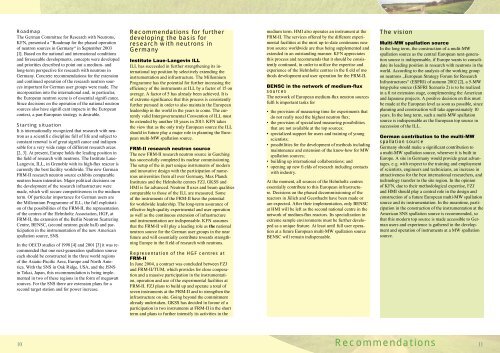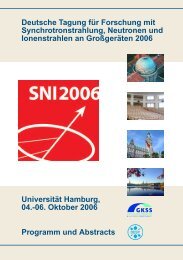Status und Perspektiven - SNI-Portal
Status und Perspektiven - SNI-Portal
Status und Perspektiven - SNI-Portal
Sie wollen auch ein ePaper? Erhöhen Sie die Reichweite Ihrer Titel.
YUMPU macht aus Druck-PDFs automatisch weboptimierte ePaper, die Google liebt.
Roadmap<br />
The German Committee for Research with Neutrons,<br />
KFN, presented a “Roadmap for the phased operation<br />
of neutron sources in Germany“ in September 2003<br />
[1]. Based on the national and international conditions<br />
and foreseeable developments, concepts were developed<br />
and priorities described to point out a medium- and<br />
long-term perspective for research with neutrons in<br />
Germany. Concrete recommendations for the extension<br />
and continued operation of the research neutron sources<br />
important for German user groups were made. The<br />
incorporation into the international and, in particular,<br />
the European neutron scene is of essential signifi cance.<br />
Since decisions on the operation of the national neutron<br />
sources also have signifi cant impacts in the European<br />
context, a pan-European strategy is desirable.<br />
Starting situation<br />
It is internationally recognized that research with neutron<br />
as a scientifi c discipline full of life and subject to<br />
constant renewal is of great signifi cance and indispensable<br />
for a very wide range of different research areas<br />
[2, 3]. At present, Europe holds the leading position in<br />
the field of research with neutrons. The Institute Laue-<br />
Langevin, ILL, in Grenoble with its high-flux reactor is<br />
currently the best facility worldwide. The new German<br />
FRM-II research neutron source exhibits comparable<br />
neutron beam intensities. Major political decisions on<br />
the development of the research infrastructure were<br />
made, which will secure competitiveness in the medium<br />
term. Of particular importance for German users are<br />
the Millennium Programme of ILL, the full exploitation<br />
of the possibilities of the FRM-II, the representation<br />
of the centres of the Helmholtz Association, HGF, at<br />
FRM-II, the extension of the Berlin Neutron Scattering<br />
Centre, BENSC, (second neutron guide hall) and participation<br />
in the instrumentation of the new American<br />
spallation source, SNS.<br />
In the OECD studies of 1998 [4] and 2001 [3] it was recommended<br />
that one next-generation spallation source<br />
each should be constructed in the three world regions<br />
of the Asiatic-Pacific Area, Europe and North America.<br />
With the SNS in Oak Ridge, USA, and the JSNS<br />
in Tokai, Japan, this recommendation is being implemented<br />
in two of these regions in the form of megawatt<br />
sources. For the SNS there are extension plans for a<br />
second target station and for power increase.<br />
Recommendations for further<br />
developing the basis for<br />
research with neutrons in<br />
Germany<br />
Institute Laue-Langevin ILL<br />
ILL has succeeded in further strengthening its international<br />
top position by selectively extending the<br />
instrumentation and infrastructure. The Millennium<br />
Programme has the potential for further increasing the<br />
efficiency of the instruments at ILL by a factor of 15 on<br />
average. A factor of 5 has already been achieved. It is<br />
of extreme significance that this process is consistently<br />
further pursued in order to also maintain the European<br />
leadership in the world in the years to come. The currently<br />
valid Intergovernmental Convention of ILL must<br />
be extended by another 10 years in 2013. KFN takes<br />
the view that as the only truly European source the ILL<br />
should in future play a major role in planning the European<br />
multi-MW spallation source.<br />
FRM-II research neutron source<br />
The new FRM-II research neutron source in Garching<br />
has successfully completed its nuclear commissioning.<br />
The setup of the in part unique instruments of modern<br />
and innovative design with the participation of numerous<br />
universities from all over Germany, Max Planck<br />
Institutes and the Helmholtz centres FZJ, GKSS and<br />
HMI is far advanced. Neutron fl uxes and beam qualities<br />
comparable to those of the ILL are measured. Some<br />
of the instruments of the FRM-II have the potential<br />
for worldwide leadership. The long-term assurance of<br />
effective high-quality experimental and user operation<br />
as well as the continuous extension of infrastructure<br />
and instrumentation are indispensable. KFN assumes<br />
that the FRM-II will play a leading role as the national<br />
neutron source for the German user groups in the near<br />
future and will essentially contribute towards strengthning<br />
Europe in the fi eld of research with neutrons.<br />
Representation of the HGF centres at<br />
FRM-II<br />
In June 2004, a contract was concluded between FZJ<br />
and FRM-II/TUM, which provides for close cooperation<br />
and a massive participation in the instrumentation,<br />
operation and use of the experimental facilities at<br />
FRM-II. FZJ plans to build up and operate a total of<br />
seven instruments at the FRM-II and to strengthen the<br />
infrastructure on site. Going beyond the commitment<br />
already <strong>und</strong>ertaken, GKSS has decided in favour of a<br />
participation in two instruments at FRM-II in the short<br />
term and plans to further intensify its activities in the<br />
medium term. HMI also operates an instrument at the<br />
FRM-II. The services offered by the different experimental<br />
facilities at the most up-to-date continuous neutron<br />
source worldwide are thus being supplemented and<br />
extended in an outstanding manner. KFN appreciates<br />
this process and recommends that it should be consistently<br />
continued, in order to utilize the expertise and<br />
experience of the Helmholtz centres in the fi eld of methods<br />
development and user operation for the FRM-II.<br />
BENSC in the network of medium-flux<br />
sources<br />
The network of European medium-flux neutron sources<br />
fulfi ls important tasks for<br />
• the provision of measuring time for experiments that<br />
do not really need the highest neutron flux;<br />
• the provision of specialized measuring possibilities<br />
that are not available at the top sources;<br />
• specialized support for users and training of young<br />
scientists;<br />
• possibilities for the development of methods including<br />
maintenance and extension of the know-how for MW<br />
spallation sources;<br />
• building up international collaborations; and<br />
• opening up new fi elds of research including contacts<br />
with industry.<br />
At the moment, all sources of the Helmholtz centres<br />
essentially contribute to this European infrastructure.<br />
Decisions on the phased decommissioning of the<br />
reactors in Jülich and Geesthacht have been made or<br />
are expected. After their implementation, only BENSC<br />
at HMI will be left as the second national centre in the<br />
network of medium-flux reactors. Its specialization in<br />
extreme sample environments must be further developed<br />
as a unique feature. At least until full user operation<br />
at a future European multi-MW spallation source<br />
BENSC will remain indispensable.<br />
The vision<br />
Multi-MW spallation source<br />
In the long term, the construction of a multi-MW<br />
spallation source as the central European next-generation<br />
source is indispensable, if Europe wants to consolidate<br />
its leading position in research with neutrons in the<br />
world. According to the analysis of the working group<br />
on neutrons „European Strategy Forum for Research<br />
Infrastructures“ (ESFRI) of autumn 2002 [2], a 5-MW<br />
long-pulse source (ESFRI Scenario 2) is to be realized<br />
in a fi rst extension stage, complementing the American<br />
and Japanese projects. A positive decision on this must<br />
be made at the European level as soon as possible, since<br />
planning and construction will take approximately 10<br />
years. In the long term, such a multi-MW spallation<br />
source is indispensable as the European top source in<br />
succession of the ILL.<br />
German contribution to the multi-MW<br />
spallation source<br />
Germany should make a significant contribution to<br />
a multi-MW spallation source, wherever it is built in<br />
Europe. A site in Germany would provide great advantages,<br />
e. g. with respect to the training and employment<br />
of scientists, engineers and technicians, an increase in<br />
attractiveness for the best international researchers, and<br />
technology transfer to the site region. In the opinion<br />
of KFN, due to their methodological expertise, FZJ<br />
and HMI should play a central role in the design and<br />
construction of a future European multi-MW spallation<br />
source and its instrumentation. In the meantime, participation<br />
in the construction of the instrumentation at the<br />
American SNS spallation source is recommended, so<br />
that this modern top source is made accessible to German<br />
users and experience is gathered in the development<br />
and operation of instruments at a MW spallation<br />
source.<br />
10 Recommendations<br />
11











